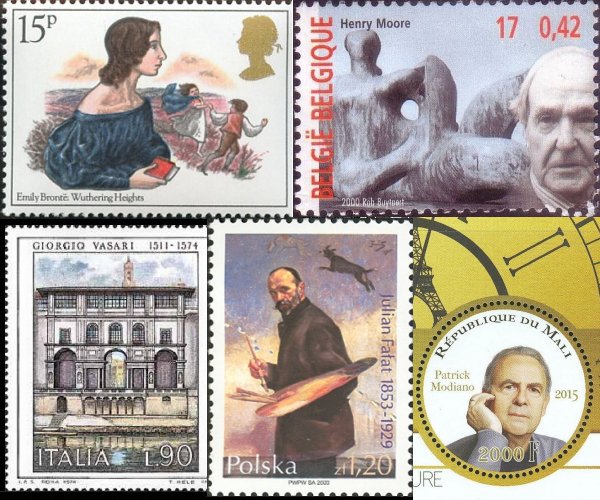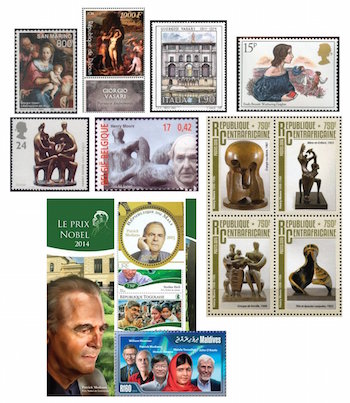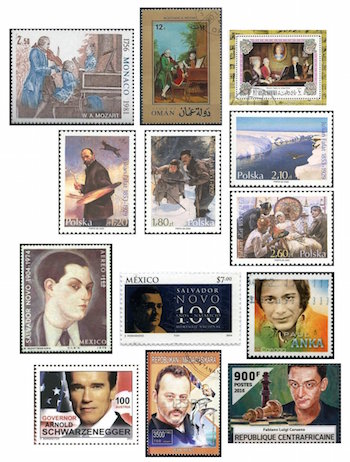The Arts on Stamps of the World — July 30
An Arts Fuse regular feature: the arts on stamps of the world.

By Doug Briscoe
July 30 brings us three very prominent figures in the arts: Giorgio Vasari, Emily Brontë, and Henry Moore. We also say happy birthday to Mozart’s sister, Polish watercolor painter Julian Fałat, Mexican writer Salvador Novo, popular entertainers Paul Anka and Arnold Schwarzenegger, and the young chess grandmaster Fabiano Caruana.
I finally started reading Vasari’s Lives of the Artists earlier this year, and with the modern marvel of the Internet and the convenience of hand-held devices, it’s easy to call up images of almost any of the works cited in the text. Invaluable for centuries as a tool for art historians, the Lives of the Most Excellent Painters, Sculptors, and Architects by Giorgio Vasari (30 July 1511 – 27 June 1574) establishes him as the father of art history. He was himself a painter and architect, whose work can be seen on a few postage stamps. From San Marino comes Adoration of the Magi (c1547) (not to be confused with another Adoration he painted in 1566-67); from Djibouti Perseus and Andromeda (1572); and from Italy the courtyard of his Uffizi Gallery in Vasari’s beloved Florence.
The author of Wuthering Heights, Emily Brontë (30 July 1818 – 19 December 1848), was an extremely reserved person whose only close friend seems to have been her sister Anne, with whom she collaborated on a series of tales about the fictional island Gondal. (None of these is extant.) She accompanied Charlotte to school in Brussels and published with her and Anne a selection of poetry under the pseudonyms Currer (Charlotte), Ellis (Emily), and Acton (Anne) Bell. Emily died, aged thirty, just a few months after her brother Branwell. Wuthering Heights has been the subject of at least three completed operas of the same name: Bernard Herrmann wrote his version between 1943 and 1951, and Carlisle Floyd’s setting was premièred in 1958. Frédéric Chaslin also wrote an operatic version. Frederick Delius also started work on a Wuthering Heights opera but abandoned it early.
Primarily a sculptor, Henry Moore (30 July 1898 – 31 August 1986) also made many drawings, the particularly noteworthy ones being those he made during the Blitz. The son of a Yorkshire coal miner who wanted a better life for his children through education, Moore is said to have decided on a career in sculpture from the age of 11. While on scholarship to Italy he visited Paris and saw there the Mesoamerican chacmool figures that would give his work such strong direction. The first Henry Moore stamp was issued by Britain in 1993 and shows the artist’s bronze Family Group (1949-50). In 2000, Belgium issued a Moore stamp with his Reclining Figure (1958), commissioned for the UNESCO building in Paris. The handsome minisheet from the Central African Republic repeats Family Group at lower left and adds Nuclear Energy (upper left, 1967), Mother and Child (upper right, 1953), and Helmet Head and Shoulders (lower right, 1952).

Three years ago French novelist Jean Patrick Modiano (born 30 July 1945) was awarded the Nobel Prize in Literature. Born to an Italian-Greek-Jewish father and a Belgian actress, Modiano learned Flemish before French and was mentored by his mother’s friend and his geometry teacher Raymond Queneau. The first of his many novels, of which a dozen or so have been translated into English, was published in 1968. In 1973, he collaborated with director Louis Malle on the screenplay for Lacombe, Lucien. Writing for the New York Times, Alexandra Alter and Dan Bilefsky called Modiano the “Marcel Proust of our time”. On his winning of the Nobel Prize he appeared on a sheet from Togo with stamps for four of the winners in other fields. Overlaid on top of this I show part of a Malian minisheet devoted to Modiano and a Maldivian stamp where, again, he shares the space (he is second from left) with four more of that year’s Nobel laureates, including in the forefront the courageous and selfless Malala Yousafzai.
Although there is no stamp specifically devoted to her, Maria Anna Walburga Ignatia Mozart (1751 – 29 October 1829), known to posterity by her nickname “Nannerl”, does appear on stamps with her brother. Today is her birthday. She toured with him and their father until she reached a “marriageable” age, whereupon her musical career came to an abrupt halt (thanks, men!). She was of course a superb pianist, though in the earlier family portrait she is shown singing, and seems to have composed some music, as well, since there are references to her work in Wolfgang’s correspondence, but none of her compositions survives. On the death of her husband in 1801, she took up music teaching and left a considerable estate when she died, aged 78. The original painting was a watercolor done in 1763, when Nannerl was twelve and Wolferl eight, by Louis de Carmontelle (1717-1806). A second family portrait, executed about twenty years later by Johann Nepomuk della Croce (1736-1819), shows Wolfgang and Nannerl at the keyboard, with a portrait of their late mother on the wall between them and their father Leopold.
The Polish painter Julian Fałat (30 July 1853 – 9 July 1929) met Crown Prince Wilhelm in a hunting party and in 1889 was invited by him (by that time Kaiser Wilhelm II) to become court painter in Berlin. He took up the position of art professor in Kraków in 1895. Since 1900 the institution has borne his name. Fałat created a great many watercolors and specialized in winter scenes. On the four stamps issued for his sesquicentennial we see Self-Portrait (1896), Athletes (hunters, 1891), Winter landscape with river and bird (1913), and On the ship (painted in Colombo, Ceylon in 1885).
Gay Mexican writer Salvador Novo (30 July 1904 – 13 January 1974) was a member of the literary group Los Contemporáneos and a co-founder of their namesake magazine in 1928. He was also involved in the creation of the avant-garde Ulysses Theater. He was fluent in French and English, even writing a couple of his books in that language. In later years, despite his relatively open homosexuality, he held a number of government positions as department head, in Foreign Affairs, National Economy, and Public Education, and was also official chronicler of Mexico City, all the while continuing his multifarious activities as a poet, writer, translator, television broadcaster, and founder (with composer Carlos Chávez) of the National Institute of Fine Arts. In 1953 he opened another theater, the first in Mexico to put on Waiting for Godot, and an associated bar and restaurant. Mexico issued a stamp just after his death and another for the hundredth anniversary of his birth.

Canadian-born Paul Anka (born July 30, 1941), of Syrian-Lebanese ancestry, recorded his first song at 14 and had a hit two years later (1957) with “Diana”. His other songwriting credits include, most famously, “She’s a Lady”, popularized by Tom Jones, and the lyrics (but not the music) for the Frank Sinatra hit “My Way”. Anka also wrote the song that became the theme music for The Tonight Show Starring Johnny Carson. He became a naturalized American citizen in 1990. The Canadian stamp from 2007 is one of four saluting popular recording artists.
“The Governator”, Arnold Schwarzenegger, who has been an American citizen (with dual Austrian nationality) since 1983, turns 70 today. He appears on an Austrian stamp from 2004, when he was Governor of California.
The Casablanca-born French actor Jean Reno is exactly one year younger than Ah-nolt. His birth name was Juan Moreno y Herrera-Jiménez. He was born 30 July 1948 to parents who had fled Franco’s Spain. Reno went to France at 17. Multilingual, he grew up with Spanish, Arabic, and French, and also speaks Italian as well as the English he displays in so many of his films.
Chess grandmaster Fabiano Caruana was born in Miami on July 30, 1992 and holds dual American and Italian citizenship. Only 14 when he achieved grandmaster status, he is now rated third in the world.
A graduate of the University of Massachusetts with a B.A. in English, Doug Briscoe worked in Boston classical music radio, at WCRB, WGBH, and WBUR, for about 25 years, beginning in 1977. He has the curious distinction of having succeeded Robert J. Lurtsema twice, first as host of WGBH’s weekday morning classical music program in 1993, then as host of the weekend program when Robert J.’s health failed in 2000. Doug also wrote liner notes for several of the late Gunther Schuller’s GM Recordings releases as well as program notes for the Boston Classical Orchestra. For the past few years he’s been posting a Facebook “blog” of classical music on stamps of the world, which has now been expanded to encompass all the arts for The Arts Fuse.
